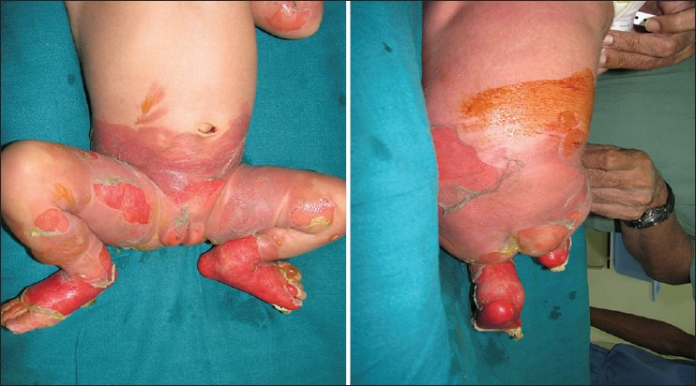Case of 11-day-old neonate brought with major scald burns on her lower limbs, trunk and upper extremities because of a hot water bag.
An 11-day-old neonate presented with deep scald burns because of a hot water bag in her lower limbs, trunk and upper extremities. The neonate’s mother was using the bag for shoulder pain while feeding the baby, when it accidentally burst all over the baby. The baby was immediately taken to a nearby hospital where she was resuscitated and referred to a higher centre for definitive management. The child arrived at the centre 3 hours after the incident.
Preliminary assessment
On examination the neonate was alert and crying in pain. The neonate’s vital signs were normal. The Lund Browder chart was used for burn assessment and was found to be 51%. Preliminary assessment of the neonate showed that 50% of the area involved to be second degree superficial burn, whereas the rest second degree deep burns. Routine blood investigations and swabs were taken.
Galveston’s formula was used for fluid calculation and as per the need, dextrose containing solutions were added to the regimen. The neonate was kept under observation in the paediatric intensive care unit and her rectal temperature was monitored every hour. The burns were dressed with an occlusive dressing and the neonate was covered with a blanket. The patient was prescribed antibiotics and analgesics and started on antibiotics according to body weight and consultation with neonatologist. The serum electrolytes and urine output were measured by weighing the diapers every hour.
The burn wound was cleaned under general anaesthesia with normal saline and polyurethane sheets and dressed with sterile paraffin tulle gras on the second day of admission. The patient’s vitals remained normal for the next 3 days. The mother was encouraged to breastfeed the baby during the course of treatment. However, the baby refused to be breastfed on the 4th day after admission and developed hypothermia associated with decreased urine output.
A neonatologist immediately assessed the patient with suspicion of septicemia and was placed on a ventilator for tachypnea and deterioration of vital parameters. A central venous catheter was placed and the antibiotics were changed. Similarly, antifungals were also added to the treatment. The neonate was fed through a nasogastric tube, blood culture was done and swab was sent for culture and sensitivity. The patient showed significant improvement after 2 days of intensive management and was weaned from the ventilator on the 7th day.
There were no signs of foul smell or soakage from the dressed wound. The antibiotics were changed after reports of culture and sensitivity. On the 8th day the dressings were changed and it was seen that except for about 10% of the burns over the abdomen and lower limbs, majority of the burns had healed. Polyurethane sheets were reapplied and the dressings were changed every alternate day.
After two weeks of the incident, homograft donated by the father was applied on the raw areas. The mother could not have donated because she herself sustained 10% scald burns over her back, gluteal region and thighs. After the graft the wounds healed completely and the neonate was discharged and advised regular follow-ups.

References
Life threatening deep scald burns in a neonate: A rare case report https://www.ncbi.nlm.nih.gov/pmc/articles/PMC3745100/




